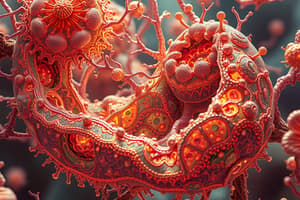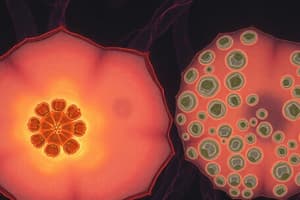Podcast
Questions and Answers
What components are present in the cytoplasm of certain cells?
What components are present in the cytoplasm of certain cells?
- Chloroplasts and lysosomes
- Organelles and mitochondria
- Plasmids and ribosomes (correct)
- Nuclei and vacuoles
What term is used to describe the fine structure of cells that requires high magnification to be observed?
What term is used to describe the fine structure of cells that requires high magnification to be observed?
- Nanoarchitecture
- Subcellular arrangement
- Ultrastructure (correct)
- Microscale
Which of the following statements is true regarding the cytoplasm of certain cells?
Which of the following statements is true regarding the cytoplasm of certain cells?
- It has a complex composition of various organelles.
- It contains numerous organelles.
- It is devoid of organelles. (correct)
- It primarily consists of DNA chromosomes.
Which component is NOT typically found in the cytoplasm of certain cells?
Which component is NOT typically found in the cytoplasm of certain cells?
For the observation of ultrastructure, which type of microscope is required?
For the observation of ultrastructure, which type of microscope is required?
What is essential for nerve cells to function normally?
What is essential for nerve cells to function normally?
What defines the distribution of ions in nerve cells?
What defines the distribution of ions in nerve cells?
Which statement regarding ion concentrations in nerve cells is incorrect?
Which statement regarding ion concentrations in nerve cells is incorrect?
What ion is predominantly kept at low concentrations inside nerve cells?
What ion is predominantly kept at low concentrations inside nerve cells?
Which of the following processes aids in maintaining the high concentration of potassium ions inside nerve cells?
Which of the following processes aids in maintaining the high concentration of potassium ions inside nerve cells?
What is the primary component of plant cell walls?
What is the primary component of plant cell walls?
How do the cell walls of fungi and bacteria differ from those of plants?
How do the cell walls of fungi and bacteria differ from those of plants?
Which of the following statements is true regarding cell walls?
Which of the following statements is true regarding cell walls?
Which material is NOT typically found in the cell walls of fungi and bacteria?
Which material is NOT typically found in the cell walls of fungi and bacteria?
What can be inferred about the diversity of cell wall materials in fungi and bacteria?
What can be inferred about the diversity of cell wall materials in fungi and bacteria?
What is one key difference in the cell walls of various organisms?
What is one key difference in the cell walls of various organisms?
Which type of organisms is characterized by having cell walls similar but differing in structure?
Which type of organisms is characterized by having cell walls similar but differing in structure?
Why might understanding the composition of cell walls be important in biological studies?
Why might understanding the composition of cell walls be important in biological studies?
Which statement about the cell walls of organisms is incorrect?
Which statement about the cell walls of organisms is incorrect?
What common feature do the cell walls of different organisms share?
What common feature do the cell walls of different organisms share?
Which of the following substances is commonly known to enter cells by diffusion?
Which of the following substances is commonly known to enter cells by diffusion?
What is one of the primary substances that leaves cells through the process of diffusion?
What is one of the primary substances that leaves cells through the process of diffusion?
Which of the following substances is NOT typically involved in cellular diffusion?
Which of the following substances is NOT typically involved in cellular diffusion?
Among the following substances, which one is absorbed by cells through diffusion rather than active transport?
Among the following substances, which one is absorbed by cells through diffusion rather than active transport?
Which pair of substances both typically leave cells by diffusion?
Which pair of substances both typically leave cells by diffusion?
Flashcards are hidden until you start studying
Study Notes
Cell Structure
- Cells contain cytoplasm, plasmids and ribosomes.
- Organelles are not present in the cytoplasm of the cell.
- The fine structure of cells, visible only with a high-magnification microscope, is called ultrastructure.
Active Transport
- Nerve cells utilize active transport to maintain high concentrations of potassium ions inside and high concentrations of sodium ions outside the cell.
Plant Cell Walls
- Plant cell walls are composed of cellulose.
- Fungal and bacterial cell walls have varied structures and chemical compositions.
Diffusion
- Oxygen, glucose, and amino acids enter most cells through diffusion.
- Carbon dioxide and urea leave most cells through diffusion.
Studying That Suits You
Use AI to generate personalized quizzes and flashcards to suit your learning preferences.




